Brendan Drumm
By Niall Hunter-Editor
 Confirmation
is expected shortly that consultant peadiatrician Prof
Brendan Drumm is to take over as Chief Executive of the
Health Service Executive, where he will be responsible
for running the health service and its 90,000 plus staff
on a day-to-day basis.
Confirmation
is expected shortly that consultant peadiatrician Prof
Brendan Drumm is to take over as Chief Executive of the
Health Service Executive, where he will be responsible
for running the health service and its 90,000 plus staff
on a day-to-day basis.
While the Department of Health has now
accepted the HSE’s recommendation that Prof Drumm (48)
be given the crucial post, his formal acceptance of the
post has yet to be announced, but should be confirmed
shortly following discussions on a remuneration package
and some administrative matters.
It is though unlikely at this stage that
the successful candidate will turn down the job offer at
the last minute, as happened with Dr Aidan Halligan last
year and which left the health service in some
uncertainty as the administrative reform process began.
Seen as a dynamic figure, Brendan Drumm
has extensive clinical, academic and research
experience, and has in the past been outspoken on the
provision of adequate hospital resources. While he has
no 'macro' administrative experience, he did chair
Comhairle na nOspideal, the consultant post regulatory
body, for five years, and has administrative experience
at clinical and academic levels.
Brendan Drumm (48) was born in
Manorhamilton, Co Leitrim, and subsequently attended
Summerhill College, Sligo, and University College
Galway, where he was conferred with a medical degree
1979. In 1981, he started his postgraduate clinical
training at the Hospital for Sick Children in Toronto,
one of the world's most prestigious children’s
hospitals. He was subsequently appointed consultant
paediatric gastroenterologist at the hospital and
Assistant Professor at the University of Toronto. In
1989 he returned to Ireland and was appointed consultant
paediatrician at the Regional Hospital, Limerick.
In 1991 he was appointed Professor and
head of the department of paediatrics at University
College Dublin (UCD) and consultant paediatric
gastroenterologist at Our Lady's Hospital for Sick
Children in Crumlin. Occupying these senior clinical and
academic positions, both in Canada and Ireland, has,
many believe, provided Professor Drumm with a good
insight into the Irish health system, from the delivery
of patient care, staff training and research through to
service and organisational management.
As Professor of Paediatrics at UCD he has
been responsible for paediatric training for all medical
students passing through the university during the past
14 years. He has also had a major input into
undergraduate medical teaching and the development of
the faculty of medicine at UCD. Given the number of
graduates he has come in contact with over the years,
and his clinical and research expertise, Professor Drumm
is very well known among medical practitioners and
clinicians around the country.
Between 1995 and 2000, he was Chairman of
Comhairle na hospital, the statutory body responsible
for regulating consultant appointments in the public
sector and advising the Minister and health agencies on
the organisation of hospital services nationally. This
position will have given him a good knowledge of the
workings of the health service on a national basis and,
indeed of the politics of service organisaiton and
development
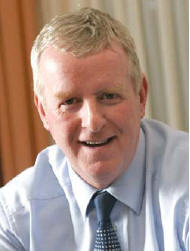 John
Moloney
John
Moloney
John (B.Agr.Sc., MBA) is
Group Managing Director of Glanbia plc and was
appointed to this position in July 2001. He was
appointed to the Board in September 1997. Born in
Sligo on November 3, 1954, while at Summerhill
College, he excelled at Basketball and was selected
to attend the trials for the Irish Schoolboy team in
his final year. He was a member of the team that won
the Connaught Championship in 1972. After graduating
from Summerhill College, he obtained his Bachelor's
Degree in Agricultural Science from UCC and an MBA
from UCG.
John then pursued
a career in the Irish meat industry and eventually
joined Waterford Foods in 1987 and held a number of
senior management positions including Head of the
Agricultural Trading Division and Chief Executive of
the Dairy Division. He previously worked with the
Department of Agriculture, Food and Forestry and in
the meat industry in Ireland. He is a board member
of the Irish Dairy Board, Repak and a member of the
Council of Irish Business and Employers
Confederation (IBEC) and Irish Management Institute
(IMI).
Patrick Devaney-Author
Patrick Devaney
grew up on a farm in County Roscommon and attended
Woodbrook National School and the Presentation Brothers
in Carrick-on-Shannon before going as a boarder to
Summerhill College, Sligo. From an early age he
enjoyed drawing birds, fish and butterflies, an activity
that was encouraged by his mother. While in Summerhill
he would occasionally write ballads and humorous verses
to amuse his classmates, then one day he wrote a poem,
‘Night in the Country’, which was published in the
Sligo Champion. The desire to be a writer was born.
After leaving Summerhill he studied Civil Engineering in
University College Galway, where his interest in art and
poetry competed with his dreams of building roads and
bridges in Africa. After the death of his father he
emigrated to New York. While working as an electrical
draughtsman he attended City College at night. In New
York he continued to write poetry, then tried his hand
at writing plays. Returning to Ireland in 1969, Patrick
obtained employment with County Kildare Vocation
Education Committee and has been working as a teacher of
Maths and English ever since. He is married with five
children and lives in Maynooth.
Writing a Story:
A story usually arises
out of something that moves me or some experience that
lingers in my mind. My first published book, Rua the
Red Grouse, grew out of my interest in the unique
plants, insects and animals to be found on a raised bog
and my fascination with grouse. The ideas underlying my
next book, The Stranger and the Pooka, arose from
two sources: a child who had been raised in a henhouse
and a woman who had gone to live as a hermit in a
West-of-Ireland bog. These images haunted my mind and I
asked myself what would happen if the child escaped into
the bog and the woman encountered him? Providing the
child with a ‘voice’ of his own was an interesting
challenge, for example, he thinks of a house as a
‘nest-place’ and night as ‘star-time’.
In my latest book, The Psychic Edge, I imagined a
boy who is being bullied and wondered what would happen
if this boy had second sight like Fionn MacCumhail had.
On a more general level, I tried to present the problems
faced by modern teenagers as realistically as possible
while adding a touch of fantasy. One thing that helps me
when writing a novel is to set out a time chart so that
changes of season and progression of events are
described accurately, for example, Rua the Red Grouse
covers the four seasons, while The Psychic Edge
starts in February and ends on the 17th of March.
Another useful device is to make a list of the
characters with their ages and appearances. Finally,
write that first draft, however crude and incomplete –
you will always be able to improve it by rewriting.
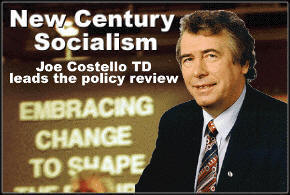 Senator
Joe Costello
Senator
Joe Costello
Born: Sligo 13/7/1945.
Educated: St. James' Well, N.S., Summerhill College,
Sligo; St. Patrick's College, Maynooth and U.C.D.,
graduating with an M.A. in 16th Century Irish History,
and a H.Dip in Education. Secondary Teacher in Loreto
College, North Great George's Street, Dublin 1, and
River Valley, Swords, Co. Dublin 1972-1990. Schoolmaster
Fellow, Trinity College, Dublin 1980. Elected to Seanad
Eireann 1989
Elected to Dublin City
Council. Elected to Dail Eireann 1992. Deputy Lord Mayor
of Dublin 1991-2. Elected to Seanad Eireann 1998
(highest Labour vote ever, topped the poll). Leader of
the Labour Party in Seanad 1997-present. Chairman of the
Prisoners' Rights Organisation 1975-1990. Vice-Chairman
of Amnesty International 1984-1987. Executive Member of
the Irish Council of Civil Liberties 1976-1990. Chairman
of the City of Dublin Vocational Educational Committee
1993-present. Chairman of the Labour Policy Development
Committee 1995-present. Labour Representative on the
British and Irish Parliamentary body 1997-present.
President of the Association of Secondary Teachers of
Ireland 1990-1991. Interests: Reading, writing, soccer
and Gaelic fan.
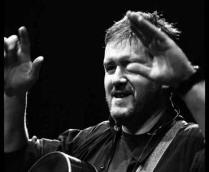 Michael
Holmes-Dervish
Michael
Holmes-Dervish
Michael is a native of Sligo town. His grand aunt Cissy
Boyd was a proficient singer, tin whistle and accordion
player. Michael’s sister Anne inherited their grand
Aunt’s musical talents and became a successful musician
in her own right firstly in Ireland, then later in the
USA. Anne taught Michael his first chords on the guitar
and through her own playing got him interested in Folk
music. Anne emigrated to the states when Michael was 16
and from her he inherited an old guitar which he used to
continue teaching himself.
While
attending Summerhill College he met and became
friends with Shane Mitchell and Liam Kelly. At this
stage Michael had been involved with a few amateur bands
and had begun playing folk music in a couple of local
pubs including the legendary Shoot the Crows. He and the
other two future founding members of Dervish began
playing together primarily for fun.
As
they began to evolve together musically the three
decided to put together a band playing original songs
and tunes, but avoiding the cliched use of traditional
instruments normally employed to insert snippets of jigs
and reels into overtly modern music Instead they tried
to utilise the flute and accordion to play pieces which
were possible on the instruments yet didn’t try to sound
Celtic or particularly Irish.
They
added a guitarist and drummer to the line-up before
finally getting singer songwriter Yvonne Cunningham to
front the band under the charming name of ‘Who Says
What.’ The line-up worked quite well and Michael wrote
and co-wrote several of the songs along with Yvonne,
while Liam and Shane found new ways of playing their
instruments which would not have been obvious within the
settings of traditional music.
Eventually the band members went their separate ways
after a productive and relatively successful three
years. Michael moved to London to find work and was
joined a year later by Liam and Shane.
While
living and working in a different country the boys
strove to stay in touch with traditional music and
because of this Michael and Liam wrote several pieces of
music together - two of which are still played
frequently by Dervish - ‘The World’s End’ and ‘The
Hungry Rock.’ They continued to search out Irish
sessions and musicians and to experiment with writing
original Irish tunes. It was during this time in England
that Michael bought his first bouzouki from the
well-known music dealer, John Alvey Turner.
His
first approach to the instrument was to translate chords
from both the standard and DADGAD guitar tunings. After
finding the basic root structures for various keys it
was a matter of playing along to tunes and exploring the
different options the bouzouki offered compared to the
guitar.
A
couple of years later while home on holidays in Sligo a
local entrepreneur approached Shane Mitchell to organise
some musicians to make a recording of Sligo music. The
assembled group comprised Shane Mitchell, Liam Kelly,
Michael Holmes, Brian McDonagh and fiddle player Martin
McGinley. The resulting album was titled ‘The Boys of
Sligo’ and the members chose the name ‘Dervish.’
The
recording enjoyed great success despite the fact that
there was no band to tour in support of it. The requests
for the group from festivals and media programmes
inspired the members to consider seriously forming
together as a working traditional band. After weighing
up the pros and cons Michael and Liam who were both
still working in London at this stage chose to commit
themselves fully to the project and moved back to Sligo
in 1989. And so the story goes...
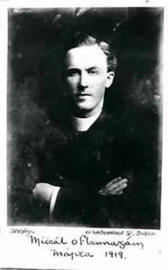 Fr.
Michael O’Flanagan was born in 1876 near Castlerea,
Co. Roscommon to parents who were native Irish speakers.
Following a primary education at Cloonboniffe N.S., he
had his first association with Sligo when he attended
secondary school at Summerhill College . On
graduating there in 1894, he entered St. Patrick’s
College, Maynooth, where he was ordained for the Diocese
of Elphin in 1900. Following his ordination he returned
to Summerhill College and worked there as a teacher
until 1904.
Fr.
Michael O’Flanagan was born in 1876 near Castlerea,
Co. Roscommon to parents who were native Irish speakers.
Following a primary education at Cloonboniffe N.S., he
had his first association with Sligo when he attended
secondary school at Summerhill College . On
graduating there in 1894, he entered St. Patrick’s
College, Maynooth, where he was ordained for the Diocese
of Elphin in 1900. Following his ordination he returned
to Summerhill College and worked there as a teacher
until 1904.
His
clerical duties soon became interlaced with efforts to
establish a viable basis for the movement towards Irish
Independence. He firmly believed that the Irish
language, rural industry and the local Church were vital
elements in the achievement of this. His skills of
oratory were matched by an originality and genius for
fundraising. Prior to one of his trips, on behalf of
Connradh na Gaeilge, to America, he cut a sod from each
of the thirty two counties of Ireland ; bringing these
with him, he invited Irish-Americans to walk on their
native soil at a dollar a time.
After
a term (1912-14) as Advent preacher at St. Sylvester in
Rome, his involvement with the people of North Sligo
began when he was appointed in 1914 as curate to the
parish of Ahamlish, serving in Cliffoney village.
Immediately on his arrival in North Sligo he encouraged
the people there to organise in defence of their rights
that were often impinged upon by oppressive
bureaucracies, landlords and the R.I.C.
Shortly he became involved in a remarkable incident that
came to be known as the ‘Cloonerco Bog Fight’. Taking on
the establishment, against the wishes of Bishop Coyne,
he agitated for turbary rights [right to cut turf] for
the local people. This situation was brought about by
the Congested District’s Board’s acquisition of the
Hippsley and Sullivan estate and their consequent
insistence on re-distributing turf cutting rights to
families who had relatives in the British Army or R.I.C.
Despite intensive correspondence by Fr. O’Flanagan to
have the people’s rights restored, the Congested
Districts Board (C.D.B.), a Government body, were
determined to reserve the bogs for people of their
choice: families having members serving with the British
army and so on. By late June local people were in a
desperate position as no turf had been cut and they were
facing the unthinkable prospect of a winter without
fuel.
Ignoring a warning by Bishop Coyne not to get involved,
Fr. O’Flanagan, addressing his congregation at Cliffoney
Church on June 29th, 1915 , told them to wait outside
for him after Mass. Here he instructed them to assemble
the next morning with their turf cutting implements. He
would lead them to the bogs where he himself would cut
the first of the forbidden turf. This was done and the
dauntless Fr. Michael led his flock to the Cloonerco
bogs. A large body of R.I.C., under Sgt. Perry, (who was
to die some years later in the Moneygold ambush)
followed and ordered the crowd to stop.
True
to his word the dauntless priest stepped behind the
spade and cut the first turf. It was a clever move as
the RIC, fearing the vengeance of the people, would be
very reluctant to arrest a priest. Some of those present
were arrested and legal action taken but the turf were
cut and saved and eventually brought down from the bogs
where they were built in a large stack close to the
R.I.C. barracks directly in front of what is now
Cliffoney Parish Hall. A large sign was placed on the
stack: “OUR OWN TURF FOR OUR OWN PEOPLE: FOREIGNERS HAVE
NO RIGHTS HERE”.
O’Flanagan survived the actions brought against him by
the authorities but Bishop Coyne, furious at this
flouting of his authority, transferred him from
Cliffoney to Crossna in Roscommon. The people were
dismayed at the removal from their midst of a priest and
leader they had come to love and respect. Walking and on
horse and ass carts they made their way in procession to
the Bishop’s palace in Sligo pleading with him that
their priest be returned to them. When this was refused
they barricaded Cliffoney Church, nailing the doors and
windows shut, thus preventing Bishop Coyne from sending
a replacement. They mounted a guard day and night to
prevent any surprise move by the Bishop. Large crowds
assembled on Sundays outside the Church to recite the
Rosary.
The
impasse lasted until Christmas 1915 when the Bishop
agreed to provide a priest ‘who would be a good Irishman
and a patriot’ to replace Fr. Michael O’Flanagan. Thus
ended the remarkable saga of the ‘Cloonerco Bog Fight’.
Father
Michael O’Flanagan played a prominent part in the War of
Independence in the following years. The freedom of
Sligo was conferred on him and an illuminated scroll
presented by Sligo Corporation in June 1918 on behalf of
a grateful people. Outside the Town Hall, according to
reports in the Sligo Champion, enthusiastic crowds
‘cheered themselves hoarse’.
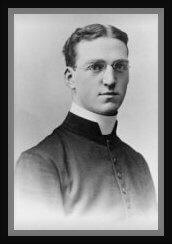 Father
Edward J. Flanagan, founder of Father Flanagan’s
Boys Home, now Girls and Boys Town, Nebraska, was born
on July 13, 1886, in Leabeg, County Roscommon, near
Ballymoe, County Galway, Ireland. He was the eighth in a
family of eleven children. He was very frail at birth;
his grandfather held him, keeping him warm by the fire.
His parents were hard-working farmers, intelligent and
very devoted to their religion. Many years later, Father
Flanagan wrote of his home:
Father
Edward J. Flanagan, founder of Father Flanagan’s
Boys Home, now Girls and Boys Town, Nebraska, was born
on July 13, 1886, in Leabeg, County Roscommon, near
Ballymoe, County Galway, Ireland. He was the eighth in a
family of eleven children. He was very frail at birth;
his grandfather held him, keeping him warm by the fire.
His parents were hard-working farmers, intelligent and
very devoted to their religion. Many years later, Father
Flanagan wrote of his home:
“The
old-fashioned home with its fireside companionship, its
religious devotion and its closely-knit family ties is
my idea of what a home should be. My father would tell
me many stories that were interesting to a child—stories
of adventure, or the struggle of the Irish people for
independence. It was from him I learned the great
science of life, of examples from the lives of saints,
scholars and patriots. It was from his life I first
learned the fundamental rule of life of the great Saint
Benedict, ‘Pray and work.’”
As Edward
grew older, his father commissioned him to take complete
care of the sheep and cattle. Edward’s duty was to keep
the animals from wandering into the dangerous peat bogs
that bordered their property on two sides. This pastoral
work gave him much time to think, to study, to read and
to pray. He noticed his father saying the rosary as he
worked, and he too, began to pray the rosary.
In a
letter to Rev. Michael O'Flanagan, Dublin County,
Ireland, April 26, 1942, Father Flanagan wrote: "You
also may not know that I was the little shepherd boy who
took care of the cattle and the sheep. That seemed to
be my job as I was the delicate member of the family and
good for nothing else, and with probably a poorer brain
than most of the other members of the family. I was
sent away to school to study for the Priesthood, as I
stated above, I wasn't much good for anything else; so
my job as a shepherd boy filled in very nicely in
preparation for my life's work afterward."
He
attended his neighborhood elementary school in
Drimatemple and entered Summerhill College, Sligo,
Ireland in the Fall of 1900, for his secondary
education. In 1904, Flanagan graduated from Summerhill
with honors and sailed for the United States. He wanted
to become a priest. Later, in answer to the question as
to why he wanted to become priest, he responded: “I
presume that what caused me to become a Priest was
because I wanted to help people – spiritually – I wanted
to teach people, and it was that desire that took hold
of me and I never had any other desire at any time in my
life.” (Letter to Miss Betty Ann Weis, January
21, 1947)
In the United States,
he enrolled in Mount Saint Mary’s College, Emmitsburg,
Maryland, and graduated in June, 1906. He entered Saint
Joseph’s Seminary, Dunwoodie, New York, in September,
1906, and left in the the spring of 1907 due to poor
health. Following a period of recuperation with his
family in Omaha, Nebraska, he left to study at the
Gregorian University, Rome, Italy. Again poor health
forced him to abandon his studies. He returned to Omaha
to rebuild his health, and in this period worked as an
accountant at the Cudahay Meat Packing Company.
In the
fall of 1909, he was accepted by the Royal Imperial
Leopold Frances University in Innsbruck, Austria. The
high altitude was good for his health, so he was able to
continue his studies there, and was ordained with the
Jesuits at Innsbruck in 1912.
When he
returned to Omaha in 1912, he was assigned to the
Diocese of Omaha, administered by Bishop Harty, who had
also graduated from Sligo in Ireland. The new Father
Flanagan celebrated his first solemn High Mass at Holy
Angels Church, Omaha in August, 1912. His first parish
assignment was Saint Patrick’s in O’Neill, after which
he was appointed Assistant Pastor to Saint Patrick’s
Parish, Omaha in March, 1913.
 Albert
Reynolds was educated at Summerhill College,
Sligo County. Prior to entering politics he was
involved in dancehall promotion and the pet-food
business. He also developed interests in local
newspapers and a cinema. His fascination with politics
arose in part from the 'Arms Trial' of
Charles Haughey, which he attended. Reynolds became
a member of Longford County Council in 1974 and in 1977
won a Dáil seat for Fianna Fáil. Reynolds was appointed
Minister for Posts and Telegraphs, and Transport and
Power in the Haughey government. He was Minister for
Industry and Commerce (1987-1988) and for Finance
(1988-1991).
Albert
Reynolds was educated at Summerhill College,
Sligo County. Prior to entering politics he was
involved in dancehall promotion and the pet-food
business. He also developed interests in local
newspapers and a cinema. His fascination with politics
arose in part from the 'Arms Trial' of
Charles Haughey, which he attended. Reynolds became
a member of Longford County Council in 1974 and in 1977
won a Dáil seat for Fianna Fáil. Reynolds was appointed
Minister for Posts and Telegraphs, and Transport and
Power in the Haughey government. He was Minister for
Industry and Commerce (1987-1988) and for Finance
(1988-1991).
When Haughey resigned in February
1992, Reynolds obtained the posts of party leader and
Taoiseach with clear majorities. He was an uneasy leader
of the Fianna Fáil – Progressive Democrat coalition
government, which ended with the 'Beef Tribunal' (1992)
arising from contradictory testimony presented to the
Tribunal by Reynolds and the leader of Progressive
Democrats, Des O'Malley. The coalition broke up and the
General Election of 1994 resulted in a loss of nine
seats for Fianna Fáil. Reynolds failed to secure his
renomination and resigned the office (14 Dec 1992), but
within a month he negotiated a new coalition with the
Labour Party. He was re-appointed Taoiseach on 12 Jan
1993. Reynolds was deeply involved in efforts to secure
a basis for an end to IRA violence. He opened up
channels of communication to the Republican movement and
to Loyalist paramilitaries. The Downing Street
Declaration was agreed with the British Prime Minister
John Major in December 1993 and an IRA cease-fire
was announced in September 1994. The successful outcome
was widely acclaimed, but within the coalition with
Labour tensions had begun to emerge. These finally came
to breaking point over an extradition case and the
appointment of the then Attorney-General as president of
the High Court. In a confused and emotional few days,
Reynolds suddenly found himself forced to resign (17 Nov
1994). Biography source:
[2]
 Fr
Rickie Devine SMA was born in Keash, Ballymote, Co
Sligo on 14 August 1931, the eldest of seven children,
two sons and five daughters, of Thomas Devine and Mary
Kate Shields. He received his secondary education at
Summerhill College, Sligo and St Joseph's SMA
College, Wilton, Cork 1945-1951. He came to the SMA
Spiritual Year programme at Cloughballymore, Kilcolgan,
Co Galway in 1951. Following this he became a member of
SMA on 2 July 1953. He completed his studies for the
priesthood at SMA College, Dromantine, Newry, Co Down
and was ordained priest on 18 December 1956 in St
Colman's Cathedral, Newry.
Fr
Rickie Devine SMA was born in Keash, Ballymote, Co
Sligo on 14 August 1931, the eldest of seven children,
two sons and five daughters, of Thomas Devine and Mary
Kate Shields. He received his secondary education at
Summerhill College, Sligo and St Joseph's SMA
College, Wilton, Cork 1945-1951. He came to the SMA
Spiritual Year programme at Cloughballymore, Kilcolgan,
Co Galway in 1951. Following this he became a member of
SMA on 2 July 1953. He completed his studies for the
priesthood at SMA College, Dromantine, Newry, Co Down
and was ordained priest on 18 December 1956 in St
Colman's Cathedral, Newry.
Following the
completion of his studies in 1957 he was assigned as a
missionary to Nigeria, to Ondo Diocese. He worked there
until 1972 when the diocese was divided and continued
working in the new diocese of Ekiti until 1983. A keen
sportsman - he played football for Sligo and was
Connacht 100m and 200m athletics champion - he became
actively involved in football and boxing organisations
in Nigeria.
He also built up a
reputation for building churches, schools, hospitals and
presbyteries. From 1983-1994 he worked in the
Archdiocese of Abuja. For a time he was the missionary
supervisor of the building of St Paul's Missionary
Seminary at Abuja.
In recognition of his
services he was awarded two honorary chieftaincy titles,
a rare distinction.
Deteriorating health
forced him to return to Ireland and from 1994-1996 he
worked in the Diocese of Elphin and was based in Dangan.
From 1997-2000 he was based at SMA House, Claregalway
where he was involved in mission promotion work. In
2000 he retired to SMA House, Blackrock Road, Cork.
Fr Devine had been in
failing health for some time and he died peacefully at
SMA House, Blackrock Road, Cork on Saturday evening, 11
June 2005 aged 73 years. He is survived by
his sisters, Eileen, Eva and Georgina and by
his brother, Tom.
Fr Devine's remains
were received at the SMA Community Chapel, Blackrock
Road, Cork where there was concelebrated Mass on Monday
13 June at 12 noon. This was followed by removal to St
Kevin's Church, Keash, Co Sligo. The Funeral Mass was
concelebrated on Tuesday 14 June at 11.00 a.m. and was
followed by burial in the Knockbrack cemetery. Fr
Fachtna O'Driscoll SMA, Provincial, was the main
celebrant and preached the homily.
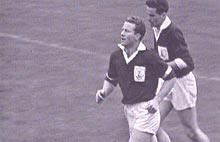 MATTIE
McDONAGH
MATTIE
McDONAGH
Sports followers
around the county, the province, the country and
overseas, were deeply saddened to learn of the recent
death of Mattie McDonagh from Ballygar.
Mattie was the only man from Connacht to win four
All-Ireland senior football medals, in 1956, 1964, ‘65
and ‘66. He won ten Connacht senior medals and a Dublin
senior medal with Erin’s Hope in 1956. Mattie played
minor hurling with Roscommon and minor football with
Galway in 1956. He also won two Connacht senior medals
with Summerhill College, Sligo and also two
Colleges senior Interprovincial medals with Connacht in
1954 and ‘55. He was also a member of the Connacht team
that won the Railway Cup in 1958.
A gentleman to his fingertips, Mattie commanded great
regard and respect wherever he went. He had a lovely,
pleasant and engaging manner which endeared him to so
many and added to his legendary status in sport in the
West and around the country.
John Keenan from Dunmore, who won three All-Ireland
medals alongside Mattie from 1964-66, paid a fine
tribute to Mattie when he spoke on the Mid-West Radio
Late Show. He recalled some of the special attributes
that made Mattie McDonagh such a favourite down through
the years.
 Dr
Brian Gibbons was brought up in
Keadue,
County Roscommon in the West of Ireland. He
was educated at Keadue National School, Summerhill
College in Sligo before graduating in medicine from
the
National University of Ireland (Galway) in
1974. He came to Yorkshire in 1976 to undertake
vocational training in general practice in Calderdale.
Dr
Brian Gibbons was brought up in
Keadue,
County Roscommon in the West of Ireland. He
was educated at Keadue National School, Summerhill
College in Sligo before graduating in medicine from
the
National University of Ireland (Galway) in
1974. He came to Yorkshire in 1976 to undertake
vocational training in general practice in Calderdale.
In 1980 he became a general
practitioner in Blaengwynfi, working in partnership with
Dr. Julian Tudor Hart, Glyncorrwg to form the Upper Afan
Practice. He was elected a Fellow of the
Royal College of General Practitioners in
1995.
The Upper Afan Practice developed a
national and international reputation for practice
innovation and research over two decades. It undertook
pioneering work on the prevention of heart disease,
developing community based general practice and
promoting patient involvement.
Since commencing work in the NHS,
Dr Gibbons has been a member of the Medical
Practitioners Union
Amicus and has served as a National Council
member for almost two decades. He is also a member of
the British Medical Association. He has served on the
West Glamorgan Morgannwg Local Medical Committees from
1980 and became Committee Secretary in 1994. For most of
the 1990s he also represented the Medical Practitioners
Union on the Welsh and UK
General Practice Committee of the BMA.
Dr Gibbons has been a member of the
Labour Party since 1980 and has been involved
in many community actions to promote the regeneration of
his local area. He has been a school governor at Cymer
Afan Comprehensive school for over 15 years.
Dr Gibbons was elected as to the
National Assembly for Wales in May 1999 as
the Welsh Labour candidate. He has served on the
National Assembly's Health and Social Services
Committee, the Audit Committee and the Economic
Development Committee. He was appointed as Deputy
Minister for Health and Social Services in October 2000.
Following the 2003 election Dr Gibbons transferred
portfolios and became Deputy Minister for Economic
Development and Transport, with special responsibility
for transport.
In January 2005 Dr Gibbons was
elevated to the Cabinet of the Welsh Assembly Government
becoming Minister for Health and Social Services.
On his appointment Dr Gibbons said:
"I would also like to pay tribute to my predecessor,
Jane Hutt, for all the hard work that she has done by
putting into place the building blocks for an improved
health service in Wales. Being the Minister with
responsibility for the NHS in Wales is of course a big
challenge but it one I am looking forward to".
He is married with two grown
children and continues to live in Blaengwynfi in the
Upper Afan Valley.
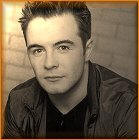 Shane
Steven Filan of Westlife made his first public
appearance when he entered the world on 5 July 1979,
born to Mae and Peter Filan. He was the youngest of
seven. He describes himself as being incredibly close to
the rest of the family, in particular to
Shane
Steven Filan of Westlife made his first public
appearance when he entered the world on 5 July 1979,
born to Mae and Peter Filan. He was the youngest of
seven. He describes himself as being incredibly close to
the rest of the family, in particular to
his sister Denise, who looks like his twin, and he loved
being the youngest: 'I got away with all sorts of
devilment. I have to admit that when I was growing up I
did get spoiled because I was the youngest. I was looked
after until I matured. I got
whatever I wanted. Then, when I got i bit older,
everybody was the same really. But when I was younger,
definitely I was spoiled rotten'. Mae and Peter have run
a restaurant, the Carlton Café, for over thirty years.
All of the Filan kids helped out in the family business
during their school holidays. Shane has been into horses
all his life, as has his whole family. 'Growing up
around horses was wonderful,' says Shane. 'There's
nothing like the feeling of freedom when you're out in
the fresh air, cantering cross-country'. But it wasn't
all play. Shane has a load of trophies from
show-jumping.
The first school he went to was Scoil Fatima in Sligo.
It was a primary school and he spent four years there
from the age of four up to second class. After that he
went to St. John's, because it was a bigger school.
Shane loved football - soccer
and Gaelic, and he was really into it. Then Michael
Jackson took over for about three of four years when he
was eight or nine. Shane had all his records, all the
videos and he used to spend hours watching them. Shane
did everything he did and can still do the moonwalk.
Then he went to secondary school, Summerhill College.
It's a huge school and has about 1200 pupils, all boys.
At Summerhill they got him into musicals and they did a
lot of school plays. Shane was a year ahead of Kian.
Mark was in Kian's year and he was a year ahead of the
two of them. Shane knew Kian around that time very well.
He had known him before but they got to be really good
mates when they started doing plays together and then
Mark came in when Shane was about 15, so he got friendly
with him. Shane got his first job when he was 16. He
worked across the road from the restaurant for a couple
of days in a hardware store and then he worked in EJ's
Menswear for a couple of days. Kian worked there as
well. After that Shane had another job for about four
months. That was in Buckley's. It's a builders'
providers store, it's got bricks and wood and stuff like
that. That was the only serious job Shane really had.
After Summerhill, Shane went to college for six months,
where he studied marketing and accountancy. But he
wasn't really happy in the college 'Limerick Regional
College', cause it wasn't what he wanted to do. Singing
was what he really wanted to do.
Shane started singing Billy Joel's Uptown Girl when he
was very young. He used to love singing and he was a
very good singer when he was young. But it was Michael
Jackson who encouraged him to go on stage. He got a lot
of inspiration from him. When Boyzone came out Shane
bought a lot of Boyzone singles and albums. Shane
started acting in plays at school. He used to do plays
in the local theatre, the Hawkswell, so he did different
plays with different production companies from Sligo.
The first play Shane did was Grease. After that he also
did Oliver and Annie get your gun.
Rev. Tommie Mannion
The death took place on Thursday last at
Roscommon County Hospital of Very Rev. Tommie Mannion,
retired PP. Prescott, Wisconsin, USA. Aged 84, deceased
had lived in retirement at Ardsallaghmore, Roscommon
since June of 2000. Son of the late Martin and the late
Ann Mannion (nee Moore, Creher, Ballyforan) he was the
youngest member of a farming family of six, four boys
and two girls. Born on March 10th 1920, he was educated
at Lismoyle NS, Summerhill College, Sligo and St
Patrick’s College, Maynooth.
His ordination to the priesthood was
delayed for seven years due to ill health and he was
ordained by Bishop John Treacy, a native of Killina,
Tulsk, on May 31st 1952 in La Cross Diocese, Wisconsin,
USA where he ministered in various Parishes for 48
years. He attributed his cure from illness to Our Lady
of Knock and the late Mr John T O’ Hanrahan, Surgeon at
Roscommon County Hospital. His first parish to minister
in was Cashton and he then transferred to Salem and had
the distinction of building Catholic Churches in both
parishes. He continued his building programme in Wausau,
Wisconsin and in his last parish, Prescott, where he
ministered as a PP for 25 years, he oversaw the building
of a convent, an extension to a school and a new
gymnasium.
Of an affable, caring and witty
disposition, he was a most engaging conversationalist
who had the ability to recall events and happenings of
yester year in great detail. For many years he was an
annual visitor in the summer months to his family
members and friends in Mid-South Roscommon. He was a
lover of all sport and in particular Gaelic games and he
had the distinction of cycling to the All Ireland Final
of 1943 involving Roscommon. He was also a lover of
Irish music, song and dance and his favourite artist was
South Roscommon singer, Brendan Shine. He is survived by
nieces, nephews and innumerable other relatives. His
remains were removed to St Brigid’s Church, Curraghboy
on Friday evening and following Concelebrated Mass on
Saturday at 3 o’clock the funeral took place to Cam
cemetery. The principal celebrant of the Mass was Right
Rev. Mons Charles Travers, PP, Roscommon.
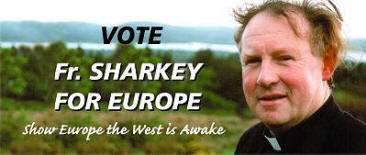 Fr.
Liam Sharkey
Fr.
Liam Sharkey
Priest
defies Rome to seek office (1999)
A ROMAN
Catholic priest is defying the Vatican and his bishop by
becoming the first Irish diocesan priest to stand for
election. Liam Sharkey wants to be an MEP and is
canvassing for a seat in this week's election in
competition with Dana, the 1970 Eurovision winner who is
campaigning in the same constituency. His seniors are
furious as the priest is breaching canon law, which
forbids clerics from "public office whenever it means
sharing in the exercise of civil power".
But Fr.
Sharkey maintains that he is not breaking church rules
because the European Parliament has so little power.
Surrounded by campaign flyers at his house in Highwood,
on the banks of Lough Arrow in Co. Sligo, the
57-year-old priest admits to being disobedient, but
insists it is in a good cause. "The people in the west
of Ireland are being ignored and forgotten. Farmers are
being put out of business, small shops are closing down
and I want to do something to stop it ," he said. His
constituency is Connaught/Ulster, the largest in
Ireland, stretching from Galway to Donegal and inland to
Cavan. His family helps as much as it can, but otherwise
Fr. Sharkey is alone, battling the massive party
machines of Fianna Fail and Fine Gael.
His
bishop, Dr. Christopher Jones, said in a statement:
"Father Sharkey neither has, nor could in any
circumstances be granted, permission to pursue an office
contrary to the canon law of the Church." Parishoners
have written to Father Sharkey to condemn him and warn
that he will be excommunicated unless he drops out of
the campaign. But Father Sharkey ignores the protests
and believes, no matter what the outcome of the election
held on Friday in the Irish Republic, that he will
return to saying Mass in his rural parish.
"My
seniors don't expect me to win. They think reality will
teach me a lesson. They think I will be humbled by a bad
vote and go back to being a good priest. Humility is
central to the Church's thinking. Father Sharkey's
chances are slim. Bookmakers give him odds of 500-1 and
an Irish Times poll showed he had support from
a mere 2% of the electorate.
Father Sharkey insists that he and Dana, a right-wing
Catholic opposed to abortion and divorce, have little in
common. he said: "Her thinking is from the Bible belt of
America. She has come back here for a quick campaign in
the hope of bringing that kind thinking to Ireland."
But Dana,
whose real name is Rosemary Scallon, still believes
Ireland needs to be saved from the perils of modern
living, particularly abortion. She returned to Galway
from her home in Alabama in May to run in the election
and hopes to capitalise on her success in November's
presidential election, when she surprised everybody by
coming third with 14% of the vote. Defeat in Friday's
vote is likely to end her role in Irish politics. She
will return to the US, where a comfortable living can be
made singing and campaigning against abortion and
divorce.
 Kian
John Francis Egan of Westlife was born in Sligo,
Ireland, on 29th April 1980, into a musical family. He's
been on stage since he was only four and he can play
more than five music instruments. It's no secret that
Kevin & Patricia Egan's children are all musical, and
Kian is definitely showing it. The fifth of seven
children - Vivienne, Gavin, Fenella, Tom, Kian, Marielle,
Colm - has been involved in plays since he can remember
and was also a part of Summerhill College's
musicals - one of them is Grease - that would later take
him from IOYou to Westlife. Even if he's now in a pop
band, he also has a passion for rock. Much to the public
generalization that he's the romeo of the band, he has
never truthfully been in any public romance until
recently dating actress gorgeous actress Jodi Albert.
Kian
John Francis Egan of Westlife was born in Sligo,
Ireland, on 29th April 1980, into a musical family. He's
been on stage since he was only four and he can play
more than five music instruments. It's no secret that
Kevin & Patricia Egan's children are all musical, and
Kian is definitely showing it. The fifth of seven
children - Vivienne, Gavin, Fenella, Tom, Kian, Marielle,
Colm - has been involved in plays since he can remember
and was also a part of Summerhill College's
musicals - one of them is Grease - that would later take
him from IOYou to Westlife. Even if he's now in a pop
band, he also has a passion for rock. Much to the public
generalization that he's the romeo of the band, he has
never truthfully been in any public romance until
recently dating actress gorgeous actress Jodi Albert.
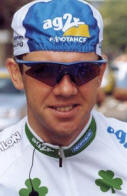 Mark
Scanlon-Cyclist:
Mark
Scanlon-Cyclist:
It's not often that Sligo gets to
see one of its own on the world stage. Cranmore's very
own Mark Scanlon is doing himself and his country proud
with some tremendous performances in this year's Tour de
France.
A native of Joe McDonnell Drive,
Cranmore, and a former pupil of St. John's National
School and Summerhill College, Scanlon sprung to
prominence in international cycling when he won the 1998
World Junior Championship in Holland on his 18th
birthday.
Son of Mary and local Haulier
Michael, the eldest of four children has seen his
cycling career rise and rise and his hard work has paid
off with his selection on the Ag2R team for the world's
greatest cycle race.
Mark has had a fine start to his
first Tour de France settling in to his support role as
leadout man for the more established members of his Ag2R
Prevoyance team including Jean-Patrick Nazon, Jaan
Kirsipuu in the sprints and Brochard in the climbs. He
also has been told to get into breaks to make sure the
team has a presence at the head of the field. These are
the opportunities where he gets to have a little of his
own success as opposed to working for the Team's Big
Guns.
Despite the wet and windy
conditions and some horrendous crashes in the first
phase and the constant shadow of the murky world of
drugs looming over the sport of cycling, the popularity
of the "Tour de France" is as high as ever with
phenomenal crowds lining the routes. Straight away,
Scanlon has clearly thrived in the atmosphere of the
Tour. It has been eleven years since Stephen Roche rode
to victory on the Champs Elysees. Mark Scanlon began the
2004 season ranked 245th in the world. Races in
Australia, Italy, France, Belgium, Estonia, Spain,
Germany and Denmark have seen the young Sligoman develop
into one of the world's most promising talents. A place
in The Tour de France was well deserved in his second
year as a professional.
Speaking to Irishcycling.com's
Shane Stokes before the fourth stage team time trial,
Mark said "The race has been fine so far, I've felt
pretty good - I did a solid enough ride in the Prologue
and then was able to help Jaan in the final few
kilometres of Stage 1. I went up and down the bunch to
bring both himself and JP [Jean Patrick Nazon] to the
front, and then did a big pull inside the final two
kilometres. I was surprised at being able to do that; I
thought it would be harder up the front at that stage."
Ministerial career:
Ray MacSharry was
born in County Sligo. He was educated locally at
Summerhill College, Sligo and became a haulier and a
small business executive. He became involved in local
politics and was first elected to Dáil Éireann in 1969.
In 1979 he was appointed Minister for State at the
Departments of Finance and Public Works, the lower rank
of Irish governmental posts below cabinet rank, often
called Junior Ministers. In December 1979 he
nominated Charles Haughey for the leadership of Fianna
Fáil. He was later rewarded for this loyalty by becoming
Minister for Agriculture in Haughey's first government.
In the short-lived Fianna Fáil government of 1982
MacSharry was appointed Tánaiste and Minister for
Finance.
Bugging Scandal in 1983:
In 1983 he
resigned from the Fianna Fáil front bench due to a
telephone-tapping controversy, when it was revealed that
as Tánaiste and Minister for Finance, he had borrowed
police tape recorders to secretly record conversations
with a cabinet colleague. MacSharry defended his action
by saying that rumours were sweeping the party that he
could be 'bought' (bribed) to support efforts to depose
Haughey; he claimed used the equipment to record any
attempts made to offer bribes. The scandal was however
primarily focused on the decision by the Minister for
Justice, Sean Doherty, to bug the phones of two leading
political journalists to discover their anti-Haughey
sources. MacSharry was a secondary but high profile
casuality of the scandal, as the equipment he had used
had been supplied by Doherty, who had requested it from
Assistant Garda (Police) Commissioner Joe Ainsworth .
Ainsworth was also forced to resign when the scandal hit
the headlines.
EU Commissioner:
In 1984,
MacSharry's rehabilitation began when he was elected to
the European Parliament. In 1987 Haughey returned to
power and MacSharry was appointed to the most senior
cabinet post, that of Minister for Finance. He committed
himself to bringing order to the public finances and the
poor economic situation. His ruthless cutting of state
spending earned him the nickname Mack the Knife.
MacSharry was subsequently rewarded by Haughey with the
appointment to be Ireland's EC Commissioner (now known
as EU Commissioner).
Ray, Charles and Diana:
As Commissioner he
famously became caught up in the rows between Britain's
warring Prince and Princess of Wales, when the Prince,
on behalf of Britain, attended a public function with
MacSharry, rather than rush to hospital to see his young
son, Prince William of Wales, who had been injured in an
accident. (MacSharry subsequently rubbished Prince
Diana's claim that the event showed Prince Charles to be
an uncaring father, revealing that Charles had spent the
entire function in minute by minute contact with the
hospital.)
Business Career:
Ray MacSharry was
widely tipped to be a future leader of Fianna Fáil but
indicated that he had no such ambition. Following the
completion of his term as Commissioner, MacSharry
retired from politics to pursue business interests.
MacSharry is currently a director on the boards of a
variety of companies including Bank of Ireland and
Ryanair Holdings. In 1999 he was appointed chairman of
Eircom plc.
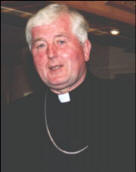 Bishop
Christopher Jones was born in Rathcroghan, Tulsk,
Co. Roscommon in 1936 and was educated at Summerhill
College, Sligo and at St. Patrick's College,
Maynooth, Co. Kildare. He also completed postgraduate
studies in University College Galway and University
College Dublin.
Bishop
Christopher Jones was born in Rathcroghan, Tulsk,
Co. Roscommon in 1936 and was educated at Summerhill
College, Sligo and at St. Patrick's College,
Maynooth, Co. Kildare. He also completed postgraduate
studies in University College Galway and University
College Dublin.
Ordained to the priesthood on 21
June 1962 he spent the early years of his priesthood as
a secondary school teacher, first in St. Muredach's
College, Ballina, Co. Mayo (1962-'63) and in Summerhill
College, Sligo (1965-'71).
Subsequently he served as Director
of Sligo Social Services (1973-'87) and for a time, as
curate in Rosses Point, Co. Sligo, before serving as
administrator in St. Mary's Parish, Sligo (1987-'94).
Persistently conscious of the needs
and rights of people who are underprivileged he served
for many years as Chairperson of the National Council
for Travelling People and continues to make
representation on behalf of travellers, refugees and
other disadvantaged peoples as a member of various
Episcopal commissions.
He was appointed Bishop of Elphin
on May 24th 1994 and ordained bishop on August 15th of
the same year.
